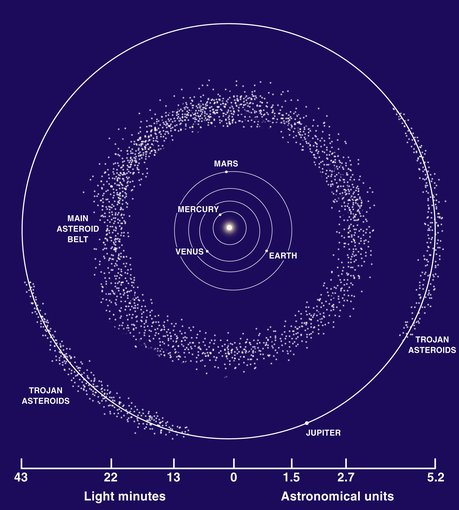Written byAaron GronstalSource
NASA Astrobiology

Oct. 2, 2019
Research Highlight
Metals and Organics from Space on the Earth, Mars and Venus

The main Asteroid Belt is located between Mars and Jupiter. The asteroid belt is just one of the sources of cosmic dust that rains down on the Solar System's terrestrial planets from space.Image credit: Lunar and Planetary Institute/NASA.
Planets in the Solar System experience a constant influx of materials from space in the form of cosmic dust. Much of this material burns up in their upper atmospheres, but it is thought that dust particles that make it through to a planet’s surface could be an important source of organic materials. Such material could have played a role in the origins of life on Earth.
A new study supported in part by the Emerging Worlds Program uses models to estimate the contribution of metals and organics from three sources of cosmic dust into the atmospheres of the terrestrial planets of the Solar System: Venus, Earth and Mars. The sources of the cosmic dust in question include Jupiter-Family comets, the Asteroid belt between Mars and Jupiter, and comets similar to Halley’s comet.
The results indicate that Jupiter-Family comets would be the main source of mass delivered for all three planets. Particles from the Asteroid belt were found to increase as planets reached the point in their orbits where they were furthest from the Sun. The study also addresses data from the Neutral Gas and Ion Mass Spectrometer on the MAVEN spacecraft.
With its thin atmosphere and relatively lower mass, cosmic dust particles at Mars experience a slower entry velocity. This affects the amount of melting that dust particles experience, and could allow ‘intact carbon’ to reach the surface Mars. However, the new study indicates that the flux of this intact carbon could be significantly smaller than previously thought. Further details concerning the types and amounts of materials estimated to reach the surface of each planet are outlined in the paper.
The study, “Cosmic dust fluxes in the atmospheres of Earth, Mars, and Venus,” was published in the journal Icarus. This work was supported by the Emerging Worlds Program. The NASA Astrobiology Program provides resources for Emerging Worlds and other Research and Analysis programs within the NASA Science Mission Directorate (SMD) that solicit proposals relevant to astrobiology research. This research is a critical part of NASA’s work to understand the Universe, advance human exploration, and inspire the next generation. As NASA’s Artemis program moves forward with human exploration of the Moon, the search for life on other worlds remains a top priority for the agency.